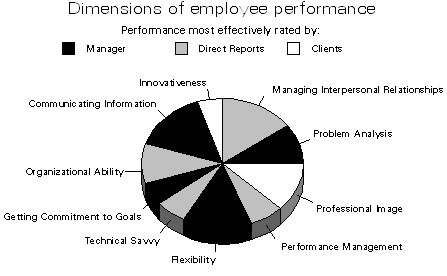
360-degree performance appraisals: More value, or just more to ignore? Although it seems like performance evaluations should be a logical and productive part of an employee’s development, they are often not anything more than ignored. We have all heard comments similar to: “Why should we do these appraisals at all? Employees just ignore them and the company spends more money on these programs without getting any results” or “I don’t see the point; I never get anything that actually helps me improve my performance!” Statements like these reflect a widely-accepted reality: few people seem to value performance appraisals. Employees often consider the process biased, with unsupported ratings that do not reflect the work they actually do. The appraisal either just pats them on the back, or criticizes them with no workable suggestions for improvement. Their review has become just another distraction during the annual (or less frequent) evaluation process. On the other hand, managers for the most part aren’t equipped to give productive feedback; often they are afraid to provide negative feedback because of legal threats or they do not want to adversely affect someone’s already small bonus; they are forced to spend hours filling out detailed forms and looking up figures or trying to remember specifics to evaluate their direct reports. But hold on Bucky, there is a way to do performance evaluations more effectively, a way to save the process from becoming disregarded. Multi-rater or “360-degree” appraisals can provide an accurate and acceptable way to evaluate performance while saving managers time and effort. 360-degree appraisals are founded on the idea that any employee’s performance is seen by many others–their manager, peers, direct reports, customers, etc. Nevertheless, none of these people see anyone else’s performance all the time. 360- degree appraisals improve on any evaluation done by one person by combining ratings from many people who see different parts of an employee’s performance. For example, direct reports probably have the best understanding of someone’s delegating skills, while managers probably see someone’s results-focus most clearly. To get a complete image of performance, then, data is gathered from others with various relationships to the employee. Many 360-degree appraisal programs also have the employee rate how they think everyone else will rate them. While someone’s selfevaluation may not be the best data on which to base pay raises, it often provides an eye-opening comparison that can serve as a good starting point for development. Gathering input from all of these points-of-view provides a fuller picture of someone’s performance. In simple terms, 360-degree appraisals give a “3-dimensional” performance report, whereas traditional performance appraisals only give a “1- dimensional” report. Traditional performance appraisals often focus on goal attainment: how close did someone come to their sales goal, or did someone meet the minimum customer service rating. Most likely, there are only a couple of people in the organization who have the data to answer these types of questions. Because of this, goal-based appraisals limit the amount of input that is available for a performance appraisal. 360-degree appraisals broaden the amount of usable input to target perceptions of an employee’s effectiveness. This approach takes advantage of the various relationships represented in the group of raters. So, while typically only an employee’s boss knows whether her/his cost-cutting goals were met for the most recent quarter, many more people will have perceptions of that employee’s financial skills, diligence, fiscal responsibility, etc–all the things necessary to reach those goals. Also, by concentrating on competencies rather than goals, the data readily lends itself to personal development. These features of 360-degree appraisals offer several advantages that help prevent it from just becoming ‘more to ignore’:
|


